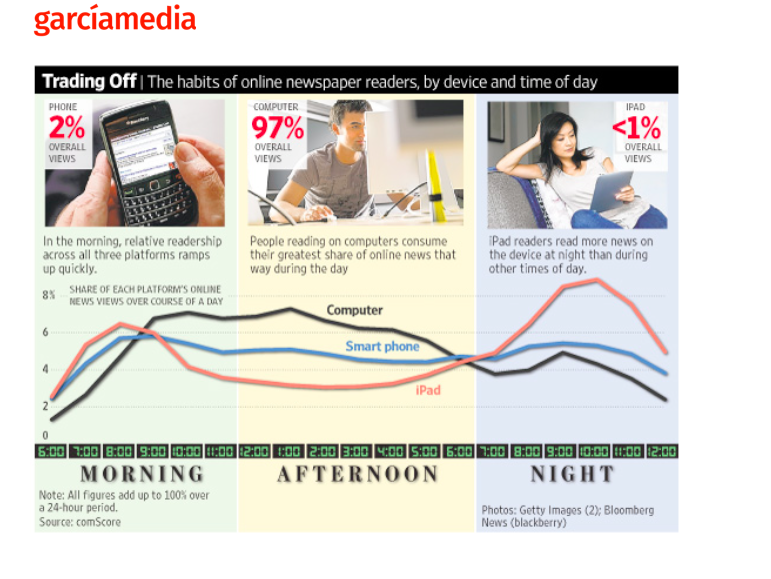I normally devote at least one class session to the tablet when I teach Multiplatform Design & Storytelling to my students at Columbia University’s Graduate School of Journalism.
The tablet continues to be one of the platforms in what I refer to as the “media quintet”: the watch, the phone, the computer, the tablet and the printed product.
This year, few of my students raised their hand when I asked how many had a tablet. Then I realized that these students were about 13 years old when the first iPad was introduced.
Overall, it felt like I was discussing a historical artifact as I reminded the students of these landmarks:
- January 27, 2010: Steve Jobs introduces the iPad in San Francisco.
- March 2, 2011: Steve Jobs introduces the iPad2 in San Francisco.

- October 2012: My first digital book, Storytelling in the Age of the iPad appears. You still can find it here: https://www.amazon.com/iPad-Design-Lab-Storytelling-Tablet-ebook/dp/B009P3ZAB2/ref=sr_1_fkmrnull_1?keywords=Mario+Garcia+Storytelling+in+the+Age+of+the+ipad&qid=1551791758&s=digital-text&sr=1-1-fkmrnull

I remember how much fun we had conducting all those iPad seminars, with me reminding the participants to “keep the finger happy” as they designed tablet editions. Illustrator Roy Blumenthal captured it all here during one of my workshops for the Media 24 group in South Africa:

At first: the rush to publish a tablet edition
- Suddenly, every magazine publisher was rushing an iPad edition to market. Sometimes the business model had not yet been created, but it didn’t matter. The idea, circa 2012, was to have an iPad edition, at any cost.

- The tablet was seen as the ultimate lean back platform. Even the research of the time showed that the tablet was primarily used in the evening.



Newspapers, too, rolled out their iPad editions, usually in the evenings. Here we see several of those, including our own Garcia Media work with the Gulf News of the United Arab Emirates, and with the Ottawa Citizen, a Postmedia publication in Canada.
The tablet editions went wild with tons of bells and whistles. Simply because it could be done, editors and designers piled it on with sound, video, pop ups.


One of the most attractive iPad editions came from Denmark’s Berlingske

Suddenly: The Daily
The Daily became the first newspaper totally created to be consumed on a tablet device.


- February 2, 2011: News Corp. CEO Rupert Murdoch walked proudly onstage at the Guggenheim Museum in New York clutching his latest project: a tablet-based newspaper, The Daily.
- December 12, 2012: News Corp closes The Daily. So, $30 million and 100-newly-hired journalists later, The Daily folded. As the editor put it: “Unfortunately, our experience was that we could not find a large enough audience quickly enough to convince us the business model was sustainable in the long-term. “
Audiences did not stay with tablet editions
That, in a nutshell, has been the reason so many of the original tablet editions are not here anymore. They were not sustainable as a business model, and readers were migrating to another platform: the smartphone.
One by one, many tablet editions of newspapers ceased to exist.
The exception, Montreal’s LaPresse+, which launched a successful iPad edition, which still exists, and followed a plan of action that included ceasing to publish its printed edition

Readers of TheMarioBlog know how much I like La Presse+ for its innovative concept (the content is free, but the advertising is creative and tailored to the tablet). Read more about La Presse+ here:
https://garciamedia.com/blog/la_presse_a_tablet_edition_success_story_in_montrea
The tablet today
The tablet, and, particularly the iPad, is here to stay, although its role continues to change. We see iPads and other tablets all around us, at restaurants, medical and dental offices, and in the hands of two interesting groups: the very young and the very old.
However, in terms of publishing the tablet is another platform in the quintet, one for which not many new products are created, but which we know will be used by some readers to read what we produce for online/mobile consumption.
It is interesting that, in 2012, while speaking to a group of the SKUP Nordic Days Conference, in Norway, I said:
I think that we will see greater consumption of news on smartphones. People will gravitate to the smaller platform. They will do more than lean forward on the phone, they may stay a little longer and lean back.”
This was the image I used at the time:

Well, it seems that the future is here.
TheMarioBlog post # 3004